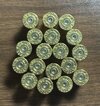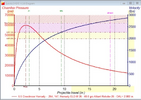CAUTION: The following post includes loading data beyond currently published maximums for this cartridge. USE AT YOUR OWN RISK. Neither the writer, The High Road, nor the staff of THR assume any liability for any damage or injury resulting from use of this information.
Trying new loads for 38 Short Colt ammo. The 38 SC brass is slightly more voluminous than 9mm brass with a slightly larger case diameter and case length ... but close nonetheless.
So naturally I looked at 9mm load data. Found the Western Powder load data PDF and look at 9mm loads for True Blue. There was no exact match for my 125 gr Berry's FN bullets but for 124 gr Berry's RN bullets it had 5.9 gr. Since these were NOT +P loads and since the 38 SC case capacity is slightly larger, I went with 6 gr. of True Blue.
Went to the range today and was getting an average of 1080 FPS with this load ... but they were "snappy", actually snappier than Barnes 357 self defense loads.
So riddle me this: why would this 38 SC load firing a 125 gr bullets at ~1080 FPS be more "snappy" than a 357 124 gr load?
Attached is a picture of the case heads of the spent 38 SC brass. I don't see of any signs of excess pressure.

Trying new loads for 38 Short Colt ammo. The 38 SC brass is slightly more voluminous than 9mm brass with a slightly larger case diameter and case length ... but close nonetheless.
So naturally I looked at 9mm load data. Found the Western Powder load data PDF and look at 9mm loads for True Blue. There was no exact match for my 125 gr Berry's FN bullets but for 124 gr Berry's RN bullets it had 5.9 gr. Since these were NOT +P loads and since the 38 SC case capacity is slightly larger, I went with 6 gr. of True Blue.
Went to the range today and was getting an average of 1080 FPS with this load ... but they were "snappy", actually snappier than Barnes 357 self defense loads.
So riddle me this: why would this 38 SC load firing a 125 gr bullets at ~1080 FPS be more "snappy" than a 357 124 gr load?
Attached is a picture of the case heads of the spent 38 SC brass. I don't see of any signs of excess pressure.

Last edited:



